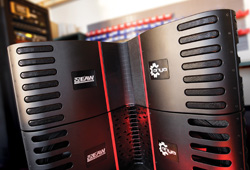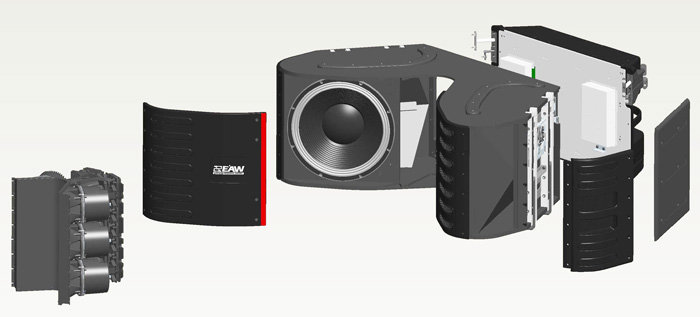
In addition, the use of smaller-format high frequency devices is fundamentally better for extreme high frequency reproduction. The absence of diaphragm break-up modes and large-dimension phase plugs makes the impulse response ideal. No aspect of the design was left un-optimized.
Diaphragm material was carefully selected. A new neodymium magnet structure was tooled that offered the proper flux in a physical package that fit our tight center-to-center constraints. The result is a 35-mm voice coil, aluminum diaphragm high frequency driver that offers high output, high power handling and excellent sound character.
A concurrent design effort was focused on a unique and patent-pending horn throat geometry that would allow 14 of these devices to converge into a single column of 1-inch apertures on a 1-inch spacing – for the entire length of an array. This consistency and granularity in the spacing enables Anya to adapt to almost any venue scenario, with the ability to create almost any coverage pattern up to nearly plus or minus 90 degrees in the vertical plane.
The selection of the mid-frequency device followed the same design requirements: high resolution, output, and fidelity. The device size and spacing was driven by the requirement to radically vary the directivity over the entire bandwidth of the device. Three vertically-stacked 5-inch midrange elements would provide the appropriate spacing and couple well with the array of 14 HF drivers, while also providing an appropriate transition from the woofers.
Duplicating this array of three drivers on either side of the HF section allows for the optimal horizontal spacing to maintain ideal pattern control, while also offering the required horizontal symmetry. We also have patented technologies that facilitate this further and are uniquely applied to Anya.
The Radial Phase Plug, first developed for the KF750 in the late 1990s, optimizes the loading of the midrange thereby perfecting the mid/high transition. Concentric Summation Array (CSA) technology minimizes and randomizes the size, shape and location of the midrange apertures to present minimal impact on the HF wavefront, allowing mid- and high-frequency passband origins to coexist in nearly the same point in space without mutual interference.
This careful integration did not eliminate the need for a top-quality midrange driver. The resulting design used as strong a neo magnet structure as the 5-inch frame could carry, driving as large a coil as can mate to the cone.
The result is a high-sensitivity and high-output device, provided by the significant BL and power handling. This device is then housed in a custom-designed cast aluminum chamber that provides optimum loading and serves as a heat sink for the magnet structure.

